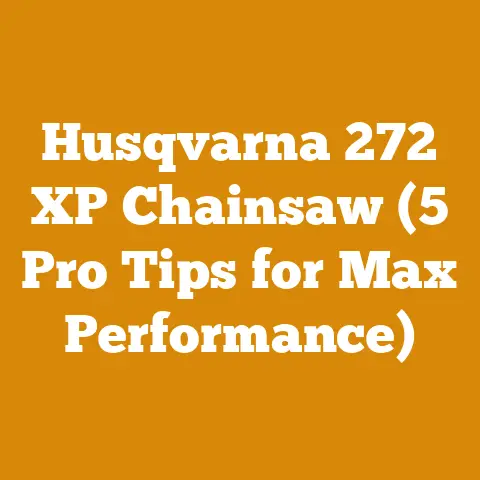MSA 300 C-O Battery Saw: Wood Processing Tips (5 Pro Techniques)
As someone deeply entrenched in the world of wood, from felling trees to splitting firewood, I understand the importance of efficient and cost-effective wood processing. The STIHL MSA 300 C-O battery chainsaw is a game-changer, offering power and portability without the hassle of gasoline. But how do you realistically budget for its use and optimize your wood processing operations? This article will delve into the intricacies of wood processing costs, offering data-driven insights, practical tips, and real-world examples to help you maximize your investment.
Decoding the True Cost of Wood Processing: A Holistic Approach
Wood processing isn’t just about the initial price of a chainsaw; it’s a complex equation involving numerous factors. Understanding these variables is crucial for accurate budgeting and maximizing profitability, whether you’re a small-scale logger, a firewood supplier, or a dedicated hobbyist.
Variable Factors That Sway the Scales
Before diving into specific costs, let’s acknowledge the key variables that significantly impact your bottom line:
- Wood Species: Hardwoods like oak and maple are denser and require more effort (and therefore, more chainsaw runtime) to cut and split than softwoods like pine or fir. This directly impacts fuel/battery consumption and labor time.
- Wood Quality: Rotten or diseased wood is not only harder to process but also has lower market value. Sound, straight-grained wood commands a higher price and is easier to work with.
- Location Accessibility: Remote logging sites increase transportation costs and can limit the types of equipment you can use. Close proximity to roads and processing facilities reduces these expenses.
- Seasonality: Wood is often easier to fell and process during the dormant season (late fall to early spring) when sap flow is minimal. However, demand for firewood typically peaks during winter, influencing pricing.
- Labor Costs: Whether you’re hiring a logging crew or splitting firewood yourself, labor is a significant expense. Wage rates vary widely depending on location and experience.
Breaking Down the Cost Components: A Step-by-Step Analysis
Let’s dissect the various cost components involved in wood processing, from timber acquisition to final product delivery.
1. Timber Purchase or Harvesting Costs: The Foundation of Your Budget
The initial cost of acquiring timber is a major factor. You have two primary options: purchasing standing timber (stumpage) or harvesting timber from your own property.
-
Stumpage Costs: Stumpage prices fluctuate based on species, quality, location, and market demand. According to Forest2Market, a leading timber market analysis firm, average pine stumpage prices in the Southern US ranged from \$20 to \$40 per ton in 2023, while hardwood stumpage prices varied significantly depending on species, with oak commanding premiums. Hardwood prices can range from \$10/ton to \$100/ton, depending on species and quality.
- Calculating Stumpage Costs: To estimate your stumpage costs, you’ll need to determine the volume of timber you plan to harvest. This often involves a timber cruise, where a professional forester estimates the board feet or cords of wood on a given area.
- My Experience: I once underestimated the volume of timber on a small plot I was planning to harvest. I ended up paying significantly more per unit volume than I had initially budgeted. It’s always best to get a professional timber cruise.
- Harvesting Costs on Your Own Property: Even if you own the land, there are still costs associated with harvesting timber. These include:
- Property Taxes: Land ownership incurs annual property taxes, which should be factored into your long-term wood processing budget.
- Reforestation Costs: Sustainable forestry practices require reforestation after harvesting. Seedlings can cost \$0.50 to \$2.00 each, and planting costs can range from \$100 to \$400 per acre.
- Management Plan Costs: Developing and implementing a forest management plan can help optimize timber production and ensure sustainable harvesting practices. These plans can cost anywhere from a few hundred dollars to several thousand, depending on the complexity.
2. Tool Costs: Investing in Efficiency and Safety
The STIHL MSA 300 C-O is a significant investment, but it’s essential to consider the total cost of ownership, including batteries, maintenance, and accessories.
- Initial Purchase Price: The MSA 300 C-O typically retails for around \$800 – \$1,000 (USD) without batteries and charger.
- Battery and Charger Costs: The STIHL AP 500 S battery, recommended for the MSA 300 C-O, can cost around \$300 – \$400. A rapid charger can add another \$150 – \$250. It’s beneficial to have multiple batteries on hand for continuous operation, especially for larger projects.
- Maintenance Costs: Battery chainsaws require less maintenance than gasoline-powered models, but regular maintenance is still crucial. This includes:
- Chain Sharpening: Dull chains reduce cutting efficiency and increase battery consumption. You can sharpen chains yourself with a file or invest in a chain grinder. Professional sharpening typically costs \$10 – \$20 per chain.
- Chain Replacement: Chains wear out over time and need to be replaced. A high-quality chainsaw chain can cost \$30 – \$50.
- Bar Maintenance: The chainsaw bar also wears down and needs to be flipped or replaced periodically. A new bar can cost \$50 – \$100.
- Grease and Lubrication: Keeping the bar and chain properly lubricated is essential for smooth operation and extended lifespan.
- Accessory Costs: Consider the cost of essential accessories like:
- Chainsaw Case: Protects your chainsaw during transport and storage.
- Fuel Can: For storing bar and chain oil.
- Personal Protective Equipment (PPE): Safety glasses, hearing protection, chainsaw chaps, and a helmet are essential for safe operation. PPE can cost \$100 – \$300.
3. Labor Wages: Valuing Your Time and Expertise
Labor costs are a significant expense, whether you’re hiring a logging crew or doing the work yourself.
- Logging Crew Wages: Logging crew wages vary depending on location, experience, and the complexity of the job. According to the US Bureau of Labor Statistics, the median hourly wage for logging workers was \$21.19 in May 2022. However, wages can range from \$15 to \$30 per hour or more, depending on the job.
- Piece-Rate Pay: Some logging crews are paid on a piece-rate basis, where they receive a certain amount per unit of wood harvested (e.g., per cord or per thousand board feet). This can incentivize productivity but also increase the risk of accidents if workers are rushing.
- DIY Labor Costs: Even if you’re doing the work yourself, it’s essential to value your time. Calculate the opportunity cost of spending time processing wood instead of pursuing other income-generating activities. Even at minimum wage, labor adds up quickly.
4. Transportation Costs: Bridging the Gap Between Forest and Firewood Pile
Transportation costs include hauling timber from the forest to a processing facility or transporting firewood to customers.
- Fuel Costs: Fuel costs are a significant expense, especially with fluctuating gasoline prices. Use a fuel consumption calculator to estimate your fuel costs based on the distance traveled and the fuel efficiency of your vehicle.
- Vehicle Maintenance: Regular vehicle maintenance is essential to prevent breakdowns and keep your transportation costs down. This includes oil changes, tire rotations, and brake repairs.
- Trucking Fees: If you’re hiring a trucking company to haul timber, trucking fees can range from \$2 to \$5 per ton-mile, depending on the distance and the type of wood.
- Permits and Licenses: Some jurisdictions require permits or licenses for transporting timber or firewood. These permits can cost \$50 – \$200 per year.
5. Processing Costs: Turning Raw Wood into Usable Products
Processing costs include the expenses associated with cutting, splitting, and stacking wood.
- Chainsaw Costs (Covered Above): The MSA 300 C-O’s battery life and cutting efficiency directly impact your processing costs.
- Splitting Costs: If you’re splitting firewood, you’ll need to factor in the cost of a wood splitter. Manual splitters are relatively inexpensive but require significant physical effort. Hydraulic splitters are more expensive but can significantly increase productivity. Hydraulic splitters can cost between \$1,000 and \$5,000, depending on the splitting force and features.
- Stacking Costs: Stacking firewood requires labor, whether you’re doing it yourself or hiring someone. Proper stacking is essential for efficient drying.
6. Drying Costs: The Patient Path to Seasoned Firewood
Drying firewood is crucial for efficient burning and reducing creosote buildup in chimneys.
- Time: The primary cost of drying firewood is time. It typically takes 6-12 months for firewood to dry properly, depending on the species, climate, and stacking method.
- Storage Space: You’ll need a dry, well-ventilated area to store your firewood while it dries. This could be a shed, a tarp-covered pile, or a dedicated firewood rack.
- Moisture Meter: A moisture meter is essential for determining when firewood is dry enough to burn. These meters can cost \$20 – \$50. Ideally, firewood should have a moisture content of 20% or less.
Depending on your location and the scale of your operations, you may need to obtain permits and licenses.
- Logging Permits: Logging permits are often required for commercial timber harvesting. These permits ensure that harvesting operations comply with environmental regulations and sustainable forestry practices. Permit fees vary depending on the location and the size of the harvest.
- Firewood Vendor Permits: Some jurisdictions require firewood vendors to obtain permits to sell firewood. These permits help prevent the spread of invasive species and ensure that firewood is properly seasoned.
- Environmental Regulations: Complying with environmental regulations can add to your costs. This includes erosion control measures, stream buffer zones, and protection of endangered species.
8. Marketing and Sales Costs: Reaching Your Target Audience
If you’re selling firewood, you’ll need to factor in marketing and sales costs.
- Advertising Costs: Advertising costs can include online ads, print ads, flyers, and signs.
- Website Costs: If you’re selling firewood online, you’ll need to factor in the cost of building and maintaining a website.
- Delivery Costs: If you’re delivering firewood to customers, you’ll need to factor in delivery costs, including fuel, vehicle maintenance, and labor.
- Payment Processing Fees: If you’re accepting credit card payments, you’ll need to factor in payment processing fees.
Real-World Examples: Putting the Pieces Together
Let’s look at a couple of real-world examples to illustrate how these cost components come together.
Example 1: Small-Scale Firewood Processor
Imagine you’re a small-scale firewood processor who harvests timber from your own property and sells firewood locally.
- Timber Costs: You own the land, so your timber costs are limited to property taxes and reforestation expenses.
- Tool Costs: You own a STIHL MSA 300 C-O with two batteries and a charger, a hydraulic wood splitter, and essential PPE.
- Labor Costs: You do most of the work yourself, but you hire a helper for splitting and stacking.
- Transportation Costs: You use your pickup truck to haul timber and deliver firewood.
- Processing Costs: You cut, split, and stack the firewood yourself.
- Drying Costs: You have a shed for storing firewood while it dries.
- Permit and Regulatory Costs: You have a firewood vendor permit.
- Marketing and Sales Costs: You advertise your firewood on Craigslist and through word-of-mouth.
Estimated Costs per Cord:
- Timber (Property Taxes/Reforestation): \$10
- Tool Maintenance (Chainsaw, Splitter): \$15
- Labor (Helper): \$40
- Transportation (Fuel, Truck Maintenance): \$20
- Permit/Regulatory: \$5
- Marketing/Sales: \$10
Total Estimated Cost per Cord: \$100
If you sell your firewood for \$200 per cord, your profit margin is \$100 per cord.
Example 2: Commercial Logging Operation
Now, consider a larger commercial logging operation that harvests timber from leased land and sells it to sawmills.
- Timber Costs: Stumpage fees, timber cruise expenses.
- Tool Costs: Multiple chainsaws (including gasoline-powered models), skidders, loaders, and other heavy equipment.
- Labor Costs: Logging crew wages, including fallers, skidder operators, and loaders.
- Transportation Costs: Trucking fees to haul timber to sawmills.
- Processing Costs: Felling, limbing, and bucking trees.
- Permit and Regulatory Costs: Logging permits, environmental compliance costs.
- Marketing and Sales Costs: Negotiating contracts with sawmills.
Estimated Costs per Thousand Board Feet (MBF):
- Stumpage: \$200
- Tool Costs (Depreciation, Maintenance): \$100
- Labor: \$300
- Transportation: \$150
- Permit/Regulatory: \$50
- Marketing/Sales: \$20
Total Estimated Cost per MBF: \$820
If the logging operation sells the timber for \$1,000 per MBF, their profit margin is \$180 per MBF.
Cost Optimization Strategies: Squeezing More Value from Your Wood
Now that we’ve broken down the cost components, let’s explore some practical tips for cost optimization and budget management.
1. Optimize Chainsaw Usage with the MSA 300 C-O
- Sharp Chains: Always use a sharp chain to maximize cutting efficiency and reduce battery consumption. A dull chain forces the saw to work harder, draining the battery faster.
- Proper Chain Tension: Maintain proper chain tension to prevent the chain from binding or derailing.
- Correct Cutting Techniques: Use proper cutting techniques to minimize effort and maximize cutting speed. Avoid forcing the saw through the wood. Let the chain do the work.
- Battery Management: Rotate batteries to avoid overheating and extend their lifespan. Fully charge batteries before each use. Store batteries in a cool, dry place. The MSA 300 C-O is designed for optimal battery performance, but proper management is key.
- Strategic Use: Use the MSA 300 C-O for tasks where its portability and lower noise are advantages, such as limbing or felling smaller trees. For larger trees or heavy-duty cutting, consider using a gasoline-powered chainsaw.
2. Maximize Wood Utilization
- Minimize Waste: Cut wood carefully to minimize waste. Use the entire tree whenever possible.
- Utilize Small Branches: Use small branches for kindling or wood chips.
- Salvage Damaged Wood: Even damaged or diseased wood can be used for certain purposes, such as making biochar or creating wildlife habitat.
3. Negotiate Favorable Prices
- Stumpage Negotiations: Negotiate stumpage prices with landowners. Research market prices to ensure you’re getting a fair deal.
- Equipment Purchases: Shop around for the best prices on equipment and supplies. Consider buying used equipment to save money.
- Labor Costs: Negotiate wage rates with logging crews or helpers. Consider offering incentives for increased productivity.
4. Improve Efficiency
- Streamline Workflow: Optimize your workflow to minimize wasted time and effort.
- Invest in Training: Provide training to workers to improve their skills and efficiency.
- Use Technology: Use technology to improve efficiency, such as GPS mapping for timber cruising or software for managing inventory and sales.
5. Minimize Transportation Costs
- Plan Efficient Routes: Plan efficient routes to minimize fuel consumption and travel time.
- Consolidate Loads: Consolidate loads whenever possible to reduce the number of trips.
- Maintain Vehicles: Keep your vehicles well-maintained to prevent breakdowns and improve fuel efficiency.
6. Control Drying Costs
- Proper Stacking: Stack firewood properly to promote air circulation and speed up drying time.
- Choose the Right Location: Choose a dry, well-ventilated location for storing firewood.
- Use a Moisture Meter: Use a moisture meter to determine when firewood is dry enough to burn, avoiding unnecessary storage time.
7. Manage Permit and Regulatory Costs
- Stay Informed: Stay informed about permit requirements and environmental regulations.
- Comply with Regulations: Comply with regulations to avoid fines and penalties.
- Seek Assistance: Seek assistance from forestry professionals or government agencies to navigate the permit process.
8. Optimize Marketing and Sales
- Target Your Audience: Identify your target audience and tailor your marketing efforts accordingly.
- Use Online Marketing: Utilize online marketing channels to reach a wider audience.
- Offer Competitive Prices: Offer competitive prices to attract customers.
- Provide Excellent Customer Service: Provide excellent customer service to build customer loyalty.
Calculating Your ROI: Is the STIHL MSA 300 C-O Worth the Investment?
Ultimately, the decision of whether to invest in the STIHL MSA 300 C-O depends on your specific needs and circumstances. To determine the return on investment (ROI), you need to compare the costs of using the MSA 300 C-O with the benefits it provides.
Costs:
- Initial purchase price of the chainsaw, batteries, and charger.
- Maintenance costs (chain sharpening, chain replacement, bar maintenance).
- Battery replacement costs (batteries typically last for several years).
Benefits:
- Increased efficiency and productivity.
- Reduced fuel costs (compared to gasoline-powered chainsaws).
- Lower maintenance costs (compared to gasoline-powered chainsaws).
- Reduced noise and emissions.
- Increased portability and maneuverability.
To calculate the ROI, you can use the following formula:
ROI = (Total Benefits – Total Costs) / Total Costs
For example, if the total benefits of using the MSA 300 C-O over a five-year period are \$5,000 and the total costs are \$2,500, the ROI would be:
ROI = (\$5,000 – \$2,500) / \$2,500 = 1 or 100%
This means that for every dollar you invest in the MSA 300 C-O, you can expect to receive \$1 in return over a five-year period.
My Personal Perspective:
I’ve found that the MSA 300 C-O is particularly valuable for tasks where portability and noise reduction are important. For example, I often use it for limbing trees in residential areas, where the noise of a gasoline-powered chainsaw would be disruptive to neighbors. The battery power gives me the freedom to work in remote locations without having to worry about carrying fuel.
Actionable Takeaways: Your Path to Efficient Wood Processing
By understanding the various cost components involved in wood processing and implementing cost optimization strategies, you can significantly improve your profitability and efficiency. Here are some actionable takeaways to guide you on your journey:
- Assess Your Needs: Determine your specific needs and circumstances before investing in equipment or making any major decisions.
- Develop a Budget: Create a detailed budget that accounts for all cost components.
- Track Your Expenses: Track your expenses carefully to identify areas where you can save money.
- Implement Cost Optimization Strategies: Implement the cost optimization strategies outlined in this article.
- Monitor Your ROI: Monitor your return on investment to ensure that your efforts are paying off.
- Stay Informed: Stay informed about market trends, new technologies, and best practices in wood processing.
- Seek Professional Advice: Don’t hesitate to seek professional advice from forestry professionals, equipment dealers, or financial advisors.
Wood processing can be a rewarding and profitable endeavor, but it requires careful planning, diligent execution, and a commitment to continuous improvement. By embracing a holistic approach to cost management and leveraging the power and efficiency of tools like the STIHL MSA 300 C-O, you can unlock the full potential of your wood processing operations. Remember, “a penny saved is a penny earned,” and in the world of wood, every board foot counts.






